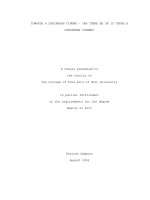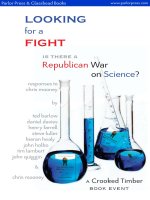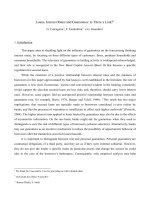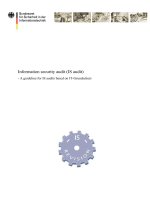is there a future for quantum chemistry
Bạn đang xem bản rút gọn của tài liệu. Xem và tải ngay bản đầy đủ của tài liệu tại đây (2.14 MB, 25 trang )
Is there a future for quantum chemistry on
supercomputers?
Jürg Hutter
Physical-Chemistry Institute, University of Zurich
Chemistry
Chemistry is the science of atomic matter, especially its
chemical reactions, but also including its properties,
structure, composition, behavior, and changes as they
relate the chemical reactions.(Wikipedia)
Chemistry is the science that invents what it studies.
Theoretical Chemistry
Theoretical chemistry is the study of chemistry via fundamental
theoretical reasoning, usually within physics and mathematics.
i h
˙
ψ = H ψ Quantum Mechanics
S = k log W Statistical Mechanics
Computational Chemistry
Computational chemistry is a branch of chemistry that uses
principles of computer science to assist in solving chemical
problems.
Quantum Mechanics Molelcular Orbital Theory
Density Functional Theory
Ab Initio Calculations
Statistical Mechanics Molecular Dynamics
Monte Carlo
Transition State Theory
Quantum Chemistry & Transition State Theory
Construct potential energy surface for a few degrees of
freedom or find a few stationary points.
Quantum Chemistry Software
•
Well tested and robust programs
•
User friendly and well documented
•
Gaussian
•
GAMESS
•
Turbomol
•
Molpro
•
ORCA, ADF, MOLCAS,
Success of Quantum Chemistry
Quantum Chemistry Software
DFT
Development of the usage of computational quantum chemistry, as measured by two different metrics. The top curve
gives the number of citations to software packages per year, while the lower curves provide the number of citations of
particular electronic structure methods (specifically pure and hybrid density functionals). Data are from the Web
Science (courtesy of Emilio Artacho).
Quantum Chemistry on Supercomputers
Quantum Chemistry on Supercomputers
NIC Jülich (Germany) 5 %
CSC (Finland) 10 %
Oak Ridge National Lab (US) 17 %
CSCS (Switzerland) 16 %
Quantum Chemistry on Supercomputers
•
Most standard applications fit on mid-range computers
Cloud/Grid Computing
•
Larger systems
→ condensed phase
→ configurational sampling
New Approaches for New Problems
Ab Initio Molecular Dynamics
R. Car and M. Parrinello, Phys. Rev. Lett. 55 2471 (1985)
Electronic Structure Calculations
+
Molecular Dynamics
Ab Initio Molecular Dynamics
System Size Number of Calculations
Standard QC 10-100 Atoms 10-100
AIMD 100-1000 Atoms 10’000 - 1’000’000
Supercomputers are needed
SIESTA, Quantum-Espresso, CPMD, CP2K
AIMD Scales on Supercomputers
History of the performance of AIMD codes on different computer
platforms (Francois Gygi, UC Davis).
AIMD: Example Application
Dye-Sensitized Solar Cells (DSSC) Grätzel Cell
1
1
Wikipedia
Projects
•
Dynamics and structure of solvent (acetonitrile) at
semiconductor (TiO2) interface
F. Schiffmann et al., J. Phys-Cond Mat 20 064206 (2008)
•
Distribution of electrolyte (I
−
, I
−
3
) at the interface
F. Schiffmann et al., PNAS 107 4830 (2010)
•
Regeneration mechanism of dye at interface
F. Schiffmann et al., PNAS 107 4830 (2010)
•
Binding and IR spectra of dye (N3) on TiO2 surface
F. Schiffmann et al., J. Phys. Chem. C 114 8398 (2010)
•
Electron transfer dynamics (dye → semiconductor)
F. Schiffmann, Thesis UZH 2010
Computational Model
• Almost complete model of a DSSC
• 1751 atom computational cell, 864
(TiO2), 60 dye+electrolyte, 828 solvent
• 9346 electrons, 22951 basis functions
• MD simulation using PBE (DFT+U)
• CPU time on 1024 cores Cray-XT5
• SCF iteration: 13.7 seconds
• MD time step: 164 seconds
DSSC: Complex Electronic Structure
Relative position of orbital levels important for charge
localization and for electron injection dynamics.
I
−
Distribution at Interface
I
−
Distribution at Interface
•
Solvent near interface cannot be described by single
dielectric constant
•
Non-monotonic shell structure distribution
•
First layer of ACN passivates the surface (no direct contact
of TiO2 to electrolyte)
•
I
−
concentration peaks at 10 Å from surface (all other ions
studied have decreasing concentrations near the interface)
I
−
/I
−
2
Association (Free Energy)
I
−
/I
−
2
Association
•
Barrierless association of I
−
/I
−
2
with dye molecules
•
I
−
3
from interaction of dye/I
2
complex with I
−
.
•
No bimolecular reaction of I
−
2
in solution necessary
Experiment finds only very small concentrations of I
−
2
in
solution
Postulated Regeneration Mechanism
Summary
•
Complex systems/interfaces can be studied with AIMD
•
Most complex model of a DSSC studied had 1751 atoms
•
Insight in various process of DSSC has been gained
•
Ion distribution at interface
•
Regeneration mechanism
•
Electron transfer dynamics
Summary
•
Computational Quantum Chemistry is still a rapidly
growing field
•
Standard applications are done by "non-experts" on small
and mid-range computers
•
Applications on High-Performance Computer is now
dominated by
•
Complex systems (condensed phase) with strong overlap
to material science and bio-sciences
•
ab initio molecular dynamics for statistical sampling









